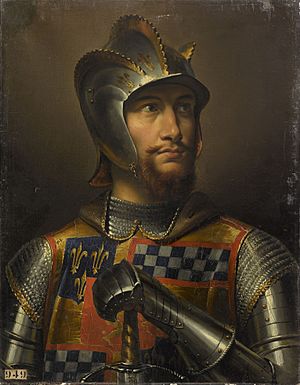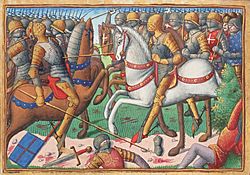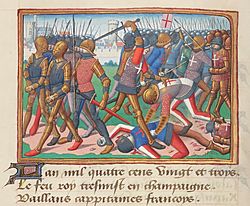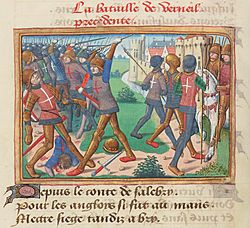John Stewart, Earl of Buchan facts for kids
Quick facts for kids
John Stewart
|
|
|---|---|
| Earl of Buchan | |

19th-century painting of Stewart
|
|
| Born | c.1381 Scotland |
| Died | 17 August 1424 Verneuil-sur-Avre, France |
| Wars and battles | |
| Offices | Constable of France |
| Noble family | House of Stuart |
| Father | Robert Stewart, Duke of Albany |
| Mother | Muriella Keith |
| Military career | |
| Years of service | 1419-1424 |
| Commands held | Scottish Army, France, Hundred Years War. |
John Stewart, Earl of Buchan (around 1381 – 17 August 1424) was a Scottish nobleman and soldier. He is famous for fighting for the Kingdom of France during the Hundred Years War. In 1419, his father, the Duke of Albany, sent him to France. He led a Scottish army of 6,000 men.
Stewart led a combined French and Scottish army at the Battle of Baugé in 1421. There, he won a big victory against the English. This battle showed that the English could be defeated. Later, in 1423, Stewart was captured by the English at the Battle of Cravant. After being released, he became the Constable of France. This meant he was the main commander of the French army. Sadly, on 17 August 1424, Buchan was killed at the Battle of Verneuil. Most of the Scottish soldiers in France also died in this battle.
Contents
Early Life and Family
John Stewart was born around 1381. His father was Robert Stewart, 1st Duke of Albany. His mother was Muriella Keith. John became the Earl of Buchan after his uncle passed away.
In 1406, King James I of Scotland was captured. John's father, Robert Stewart, became the Regent of Scotland. This made him the most powerful person in Scotland.
John Stewart married Elizabeth Douglas. She was the daughter of Archibald Douglas, 4th Earl of Douglas. They had one child, a daughter named Margaret Stewart. She later married George Seton.
Fighting in the Hundred Years' War

In 1419, John Stewart's father sent him to France. He went with an army of 6,000 Scottish soldiers. They sailed to La Rochelle using Spanish ships. At first, the French people did not like the Scottish soldiers much. This was because the Scots loved food and drink. But their success in battle soon made them very welcome.
Stewart and Gilbert Motier de La Fayette led the French and Scottish armies. They fought at the Battle of Baugé on 21 March 1421. They won a huge victory over the English. This was the first major defeat for the English in the Hundred Years' War in a long time. Buchan was ordered to defend Anjou against the Duke of Clarence. Clarence was the brother of King Henry V of England. Clarence was one of the first to fall in the battle.
The victory at Baugé greatly boosted the spirits of the Scots and French. It proved that the English were not unbeatable. After hearing about the win, Pope Martin V said that "the Scots are well-known as an antidote to the English."
Captured at Cravant

In the summer of 1423, Buchan led a mixed force of French and Scottish soldiers. They faced an English and Burgundian army at the village of Cravant. This was near a bridge and a river crossing. Buchan's forces had more soldiers than the English and Burgundians. The English and Burgundian army had about 4,000 men. They were led by Thomas Montacute, 4th Earl of Salisbury.
For three hours, both armies waited. Neither side wanted to cross the river first. Finally, Salisbury's army began to cross the river. English archers shot arrows to cover them. Another English group crossed the bridge. They split the French army.
When the French soldiers started to retreat, the Scots refused to run. They were cut down by the hundreds. More than 3,000 Scots died at the bridge or along the river. Over 2,000 were taken prisoner. This included the Earl of Buchan.
After the battle, Buchan was exchanged for other prisoners. In 1424, he was released. He was then made Constable of France. This meant he was the top commander of the French army. To make up for the losses at Cravant, new Scottish troops arrived in France.
The Battle of Verneuil

Even with new soldiers, disaster soon struck Stewart and his Scottish army. On 17 August 1424, Buchan was killed at the Battle of Verneuil. Most of the Scottish soldiers in France died with him. Buchan and his generals chose to fight the English army in an open battle. The English army was led by John of Lancaster, 1st Duke of Bedford.
Bedford's army attacked from the south. They tried to get behind the Scots. The French allies left the Scots alone. The Scots were almost completely surrounded. They fought fiercely in a last stand, but they were overwhelmed.
Verneuil was one of the bloodiest battles of the Hundred Years War. The English called it a second Agincourt. About 6,000 allied soldiers were killed. This included 4,000 Scots. The English lost 1,600 men. This was a very high number for them. It showed how fierce the fight was. The Earl of Douglas also died in this battle, fighting alongside Buchan.
Legacy
John Stewart's death had important effects in Scotland. His death weakened his brother, Murdoch Stewart, Duke of Albany. Murdoch was soon arrested and executed by James I of Scotland. This led to the downfall of the Albany Stewarts family.
Today, a statue of John Stewart is shown in the Galerie des Batailles. This is a famous gallery in the Château de Versailles in France. It opened in 1837.
See also


